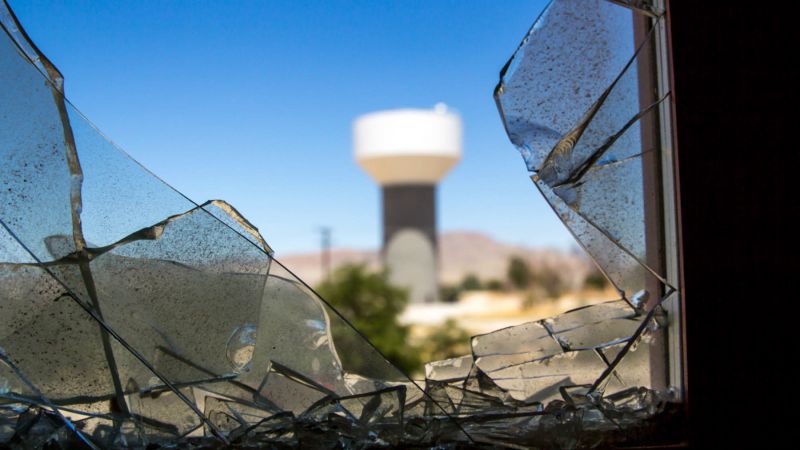Military Bases’ Contamination Will Affect Water For Generations
Published on by Water Network Research, Official research team of The Water Network in Government
At 149 current and former U.S. military bases, the contamination is so severe that they have been designated Superfund sites by the EPA, meaning they are among the most hazardous areas in the country requiring cleanup.

Many of the buildings left on the former George Air Force Base are empty, including the hospital, which sits near a water tower. (Corinne Roels/News21)
By Corinne Roels, Briana Smith and Adrienne St. Clair | News21. Published Aug. 14, 2017.
Once a fighter jet training base critical to the Cold War, little remains of the former George Air Force Base but rows of dilapidated houses, a dismantled military hospital and dangerous chemicals from pesticides, jet fuels and other hazardous wastes that have poisoned the water for decades.
“Now when I see the base today, areas of it look like a war zone,” said Frank Vera, an Air Force veteran stationed on the base in the early 1970s. “I don’t think people know what to do with some of these areas because they are so contaminated.”
George is among at least 400 active and closed military installations nationwide where the use of toxic chemicals has contaminated or is suspected of contaminating water on bases and nearby communities with chemicals ranging from cleaning solvents and paints to explosives and firefighting foam, according to a News21investigation.
One of those installations, Hill Air Force Base just north of Salt Lake City, is both one of the state’s largest employers, with 21,000 employees, and a Superfund site. Since 1987, the EPA has been monitoring the base, where more than 60 chemicals were found in soil and groundwater. According to EPA records, an “unsafe level of contamination” still exists on some areas of the base.
“Even though the DOD has made significant strides in identifying and investigating the level of contamination at domestic base sites, the pace of actual cleanup has been quite slow,” according to a research study from the Berkeley School of Law. “As the Governmental Accountability Office (GAO) recently found, ‘most of the time and money has been spent studying the problem.'”
According to a 2017 GAO report, the Department of Defense already has spent $11.5 billion on evaluations and environmental cleanup of closed bases, and it estimates $3.4 billion more will be needed.
In March, the DOD said it would be testing the water at 395 active and closed bases across the country to determine whether perfluorinated compounds are contaminating the drinking water on bases and in communities around them.
Originally developed by corporate giants 3M and DuPont for use in consumer products like Teflon, Scotchgard and stain-proof clothing, these chemicals, known as per- and polyfluorinated alkyl substances (PFAS), were used by the DOD since the 1970s in firefighting foam to extinguish jet fuel fires.
In 2012, the EPA added PFAS to its list of unregulated contaminants that may be hazardous to human health, though records indicate the Pentagon knew of the hazards decades earlier. In 1981, the Air Force Aerospace Medical Research Laboratory conducted studies that found that exposure to earlier variations of PFAS were harmful in female rats and caused behavioral changes in offspring.
Read full article: News21
Attached link
https://vimeo.com/228869206Media
Taxonomy
- Decontamination
- Decontamination
- Contaminant Removal
- Toxins
- Contaminant Movement Mapping
- Utility Management
- Hydrochemistry
- Army